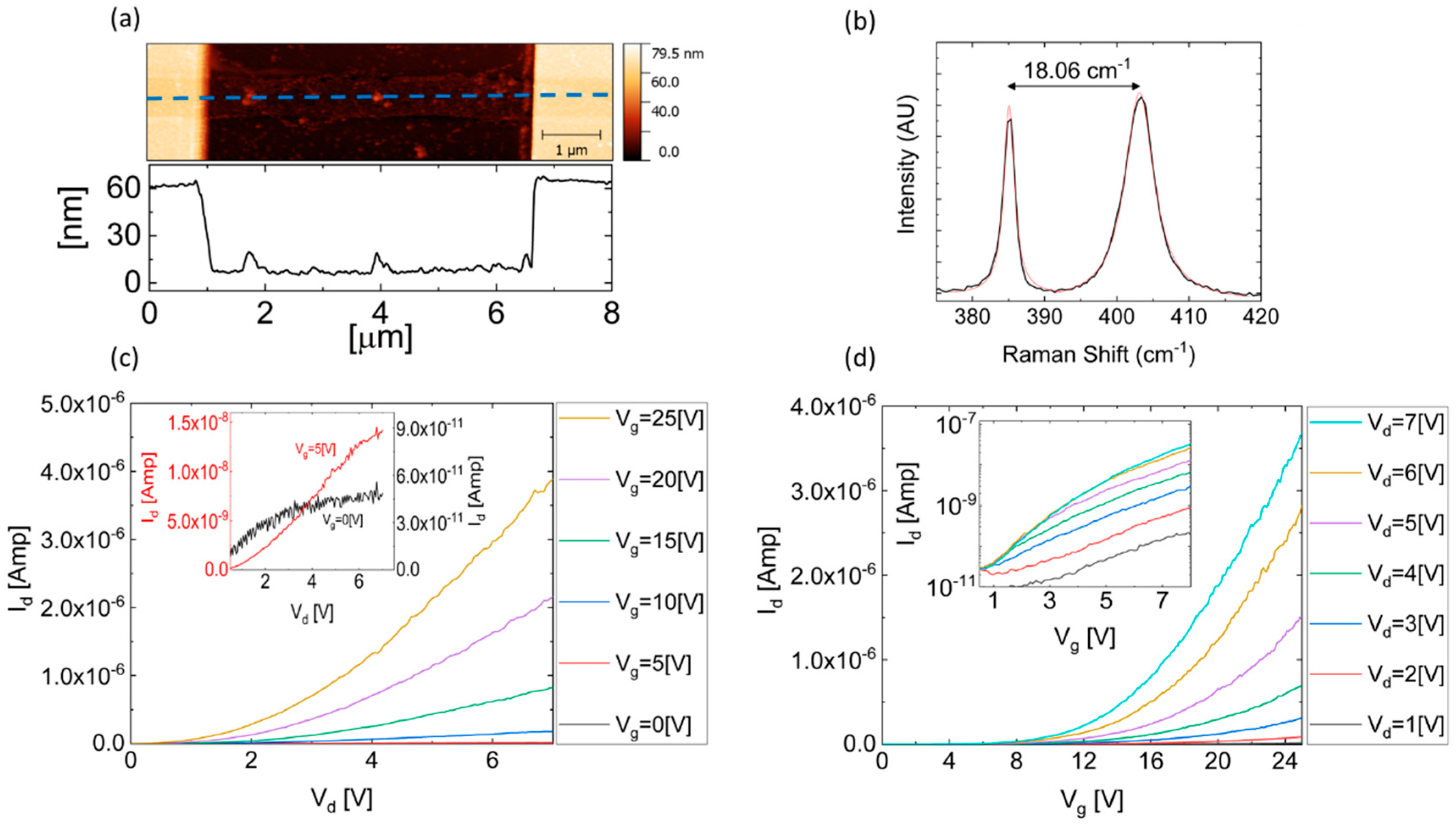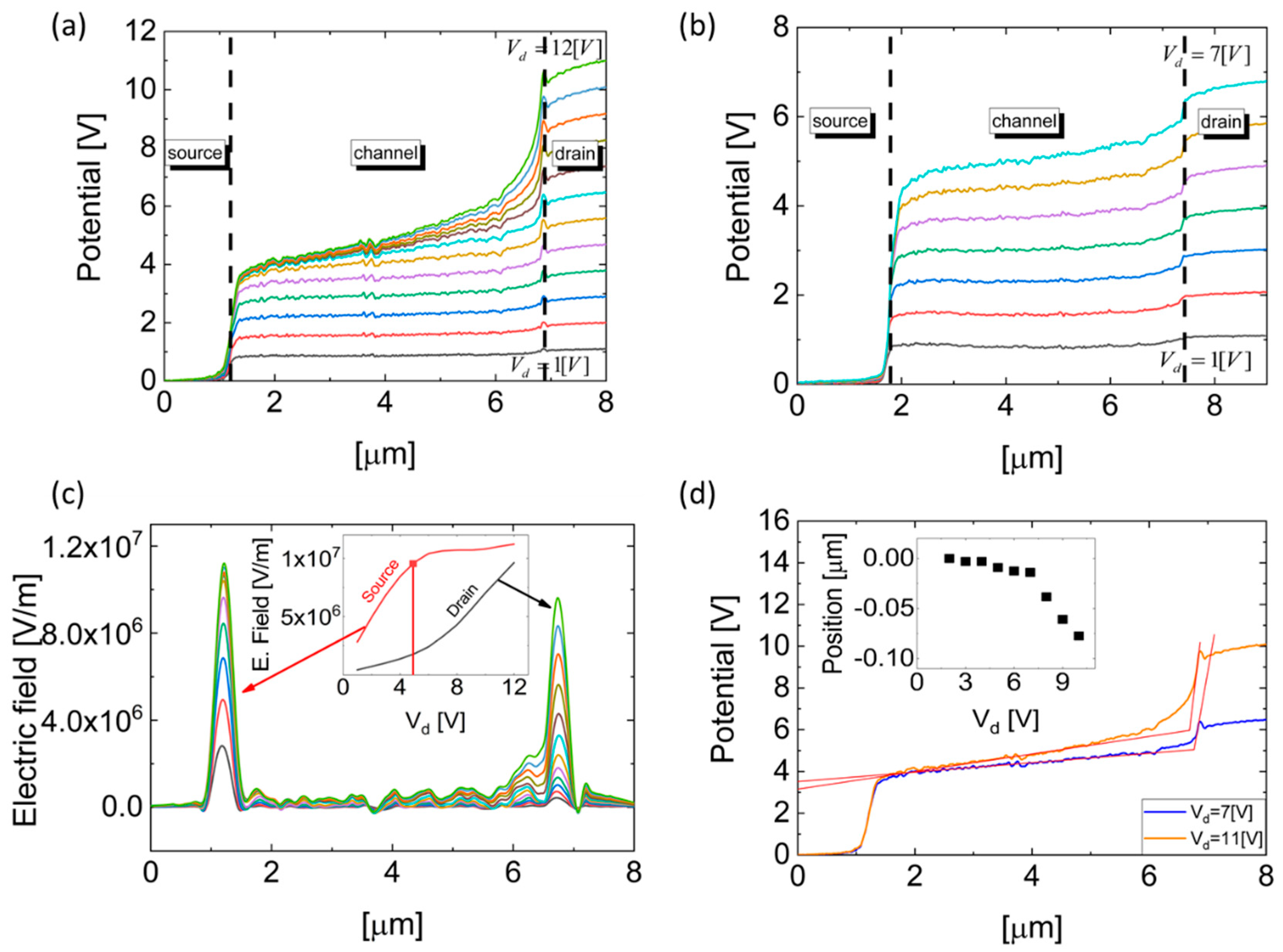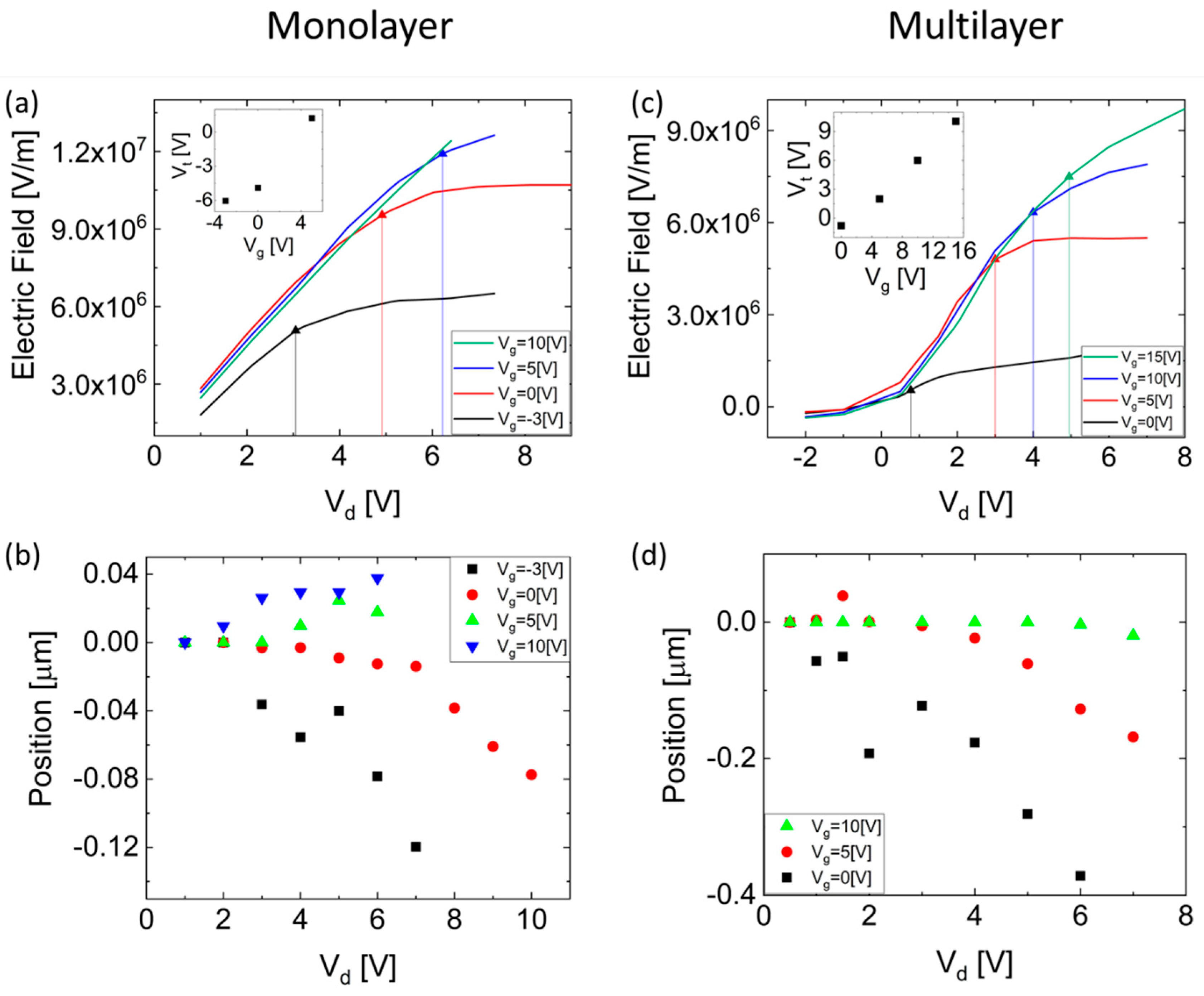Pinch-Off Formation in Monolayer and Multilayers MoS2 Field-Effect Transistors
Abstract
:1. Introduction
2. Materials and Methods
3. Results and Discussion
4. Conclusions
Author Contributions
Funding
Acknowledgments
Conflicts of Interest
References
- Islam, A.E. Current Status of Reliability in Extended and beyond CMOS Devices. IEEE Trans. Device Mater. Reliab. 2016, 16, 647–666. [Google Scholar] [CrossRef]
- Iannaccone, G.; Bonaccorso, F.; Palacios, T.; Colombo, L.; Seabaugh, A.; Fiori, G.; Neumaier, D.; Banerjee, S.K. Electronics based on two-dimensional materials. Nat. Nanotechnol. 2014, 9, 768–779. [Google Scholar]
- Yoon, Y.; Ganapathi, K.; Salahuddin, S. How good can monolayer MoS2 transistors be? Nano Lett. 2011, 11, 3768–3773. [Google Scholar] [CrossRef] [PubMed]
- Radisavljevic, B.; Radenovic, A.; Brivio, J.; Giacometti, V.; Kis, A. Single-layer MoS2 transistors. Nat. Nanotechnol. 2011, 6, 147–150. [Google Scholar] [CrossRef] [PubMed]
- Liu, H.; Neal, A.T.; Ye, P.D. Channel Length Scaling of MoS2 MOSFETs. ACS Nano 2012, 6, 8563–8569. [Google Scholar] [CrossRef]
- Kim, S.; Konar, A.; Hwang, W.S.; Lee, J.H.; Lee, J.; Yang, J.; Jung, C.; Kim, H.; Yoo, J.B.; Choi, J.Y.; et al. High-mobility and low-power thin-film transistors based on multilayer MoS2 crystals. Nat. Commun. 2012, 3, 1011–1017. [Google Scholar] [CrossRef] [PubMed]
- Wang, Q.H.; Kalantar-Zadeh, K.; Kis, A.; Coleman, J.N.; Strano, M.S. Electronics and optoelectronics of two-dimensional transition metal dichalcogenides. Nat. Nanotechnol. 2012, 7, 699–712. [Google Scholar] [CrossRef] [PubMed]
- Lopez-Sanchez, O.; Lembke, D.; Kayci, M.; Radenovic, A.; Kis, A. Ultrasensitive photodetectors based on monolayer MoS2. Nat. Nanotechnol. 2013, 8, 497–501. [Google Scholar] [CrossRef] [PubMed]
- Perkins, F.K.; Friedman, A.L.; Cobas, E.; Campbell, P.M.; Jernigan, G.G.; Jonker, B.T. Chemical vapor sensing with monolayer MoS2. Nano Lett. 2013, 13, 668–673. [Google Scholar] [CrossRef]
- Late, D.J.; Huang, Y.K.; Liu, B.; Acharya, J.; Shirodkar, S.N.; Luo, J.; Yan, A.; Charles, D.; Waghmare, U.V.; Dravid, V.P.; et al. Sensing behavior of atomically thin-layered MoS2 transistors. ACS Nano 2013, 7, 4879–4891. [Google Scholar] [CrossRef]
- Xiao, D.; Liu, G.B.; Feng, W.; Xu, X.; Yao, W. Coupled spin and valley physics in monolayers of MoS2 and other group-VI dichalcogenides. Phys. Rev. Lett. 2012, 108, 196802. [Google Scholar] [CrossRef] [PubMed]
- Klinovaja, J.; Loss, D. Spintronics in MoS2 monolayer quantum wires. Phys. Rev. B 2013, 88, 075404. [Google Scholar] [CrossRef]
- Chorkendorff, I.; Bonde, J.; Jorgensen, K.P.; Horch, S.; Jaramillo, T.F.; Nielsen, J.H. Identification of Active Edge Sites for Electrochemical H2 Evolution from MoS2 Nanocatalysts. Science 2007, 317, 100–102. [Google Scholar]
- Tsai, M.L.; Su, S.H.; Chang, J.K.; Tsai, D.S.; Chen, C.H.; Wu, C.I.; Li, L.J.; Chen, L.J.; He, J.H. Monolayer MoS2 heterojunction solar cells. ACS Nano 2014, 8, 8317–8322. [Google Scholar] [CrossRef] [PubMed]
- Li, T.; Wan, B.S.; Du, G.; Zhang, B.S.; Zeng, Z.M. Electrical performance of multilayer MoS2 transistors on high-kappa Al2O3 coated Si substrates. AIP Adv. 2015, 5, 7. [Google Scholar]
- Li, X.; Zhu, H. Two-dimensional MoS2: Properties, preparation, and applications. J. Mater. 2015, 1, 33–44. [Google Scholar] [CrossRef]
- Liu, W.; Sarkar, D.; Kang, J.; Cao, W.; Banerjee, K. Impact of Contact on the Operation and Performance of Back-Gated Monolayer MoS2 Field-Effect-Transistors. ACS Nano 2015, 9, 7904–7912. [Google Scholar] [CrossRef]
- Gurugubelli, V.K.; Karmalkar, S. Analytical theory of the space-charge region of lateral p-n junctions in nanofilms. J. Appl. Phys. 2015, 118, 034503. [Google Scholar] [CrossRef]
- Chaves, F.A.; Jiménez, D. Electrostatics of two-dimensional lateral junctions. Nanotechnology 2018, 29, 275203. [Google Scholar] [CrossRef] [Green Version]
- Gong, C.; Colombo, L.; Wallace, R.M.; Cho, K. The Unusual Mechanism of Partial Fermi Level Pinning at Metal-MoS2 Interfaces The Unusual Mechanism of Partial Fermi Level Pinning at Metal-MoS2 Interfaces. Nano Lett. 2014, 14, 1714–1720. [Google Scholar] [CrossRef]
- Nipane, A.; Jayanti, S.; Borah, A.; Teherani, J.T. Electrostatics of lateral p-n junctions in atomically thin materials. J. Appl. Phys. 2017, 122, 194501. [Google Scholar] [CrossRef]
- Sohn, A.; Moon, H.; Kim, J.; Seo, M.; Min, K.A.; Lee, S.W.; Yoon, S.; Hong, S.; Kim, D.W. Band Alignment at Au/MoS2 Contacts: Thickness Dependence of Exfoliated Flakes. J. Phys. Chem. C 2017, 121, 22517–22522. [Google Scholar] [CrossRef]
- Chiu, M.-H.; Zhang, C.; Shiu, H.-W.; Chuu, C.-P.; Chen, C.-H.; Chang, C.-Y.S.; Chen, C.-H.; Chou, M.-Y.; Shih, C.-K.; Li, L.-J. Determination of band alignment in the single-layer MoS2/WSe2 heterojunction. Nat. Commun. 2015, 6, 7666. [Google Scholar] [CrossRef] [PubMed]
- Vilarinho, P.M.; Rosenwaks, Y.; Angus, K. Scanning Probe Microscopy: Characterization, Nanofabrication and Device Application of Functional Materials; Kluwer Academic Publishers: Norwell, MA, USA, 2002. [Google Scholar]
- Choi, S.; Shaolin, Z.; Yang, W. Layer-number-dependent work function of MoS2 nanoflakes. J. Korean Phys. Soc. 2014, 64, 1550–1555. [Google Scholar] [CrossRef]
- Robinson, B.J.; Giusca, C.E.; Gonzalez, Y.T.; DKay, N.; Kazakova, O.; Kolosov, O.V. Structural, optical and electrostatic properties of single and fewlayers MoS2: Effect of substrate. 2D Mater. 2015, 2, 15005. [Google Scholar] [CrossRef]
- Kim, J.H.; Lee, J.; Kim, J.H.; Hwang, C.C.; Lee, C.; Park, J.Y. Work function variation of MoS2 atomic layers grown with chemical vapor deposition: The effects of thickness and the adsorption of water/oxygen molecules. Appl. Phys. Lett. 2015, 106, 251606. [Google Scholar] [CrossRef]
- Lee, S.Y.; Kim, U.J.; Chung, J.; Nam, H.; Jeong, H.Y.; Han, G.H.; Kim, H.; Oh, H.M.; Lee, H.; Kim, H.; et al. Large Work Function Modulation of Monolayer MoS2 by Ambient Gases. ACS Nano 2016, 10, 6100–6107. [Google Scholar] [CrossRef] [PubMed]
- Varghese, J.O.; Agbo, P.; Sutherland, A.M.; Brar, V.W.; Rossman, G.R.; Gray, H.B.; Heath, J.R. The influence of water on the optical properties of single-layer molybdenum disulfide. Adv. Mater. 2015, 27, 2734–2740. [Google Scholar] [CrossRef]
- Chen, K.; Wan, X.; Xie, W.; Wen, J.; Kang, Z.; Zeng, X.; Chen, H.; Xu, J. Lateral Built-In Potential of Monolayer MoS2-WS2In-Plane Heterostructures by a Shortcut Growth Strategy. Adv. Mater. 2015, 27, 6431–6437. [Google Scholar] [CrossRef]
- Lan, F.; Tao, Q.; Li, G. Investigation of electrical properties of contact between Molybdenum disulfide and different metals. In Proceedings of the 2015 IEEE 15th International Conference on Nanotechnology (IEEE-NANO), Rome, Italy, 27–30 July 2015; pp. 617–620. [Google Scholar]
- Chiarella, F.; Barra, M.; Carella, A.; Parlato, L.; Sarnelli, E.; Cassinese, A. Contact-resistance effects in PDI8-CN2 n-type thin-film transistors investigated by Kelvin-probe potentiometry. Org. Electron. 2016, 28, 299–305. [Google Scholar] [CrossRef]
- Chianese, F.; Chiarella, F.; Barra, M.; Carella, A.; Cassinese, A. Scanning Kelvin Probe Microscopy investigation of the contact resistances and charge mobility in n-type PDIF-CN2 thin-film transistors. Org. Electron. 2018, 52, 206–212. [Google Scholar] [CrossRef]
- He, G.; Ghosh, K.; Singisetti, U.; Ramamoorthy, H.; Somphonsane, R.; Bohra, G.; Matsunaga, M.; Higuchi, A.; Aoki, N.; Najmaei, S.; et al. Conduction Mechanisms in CVD-Grown Monolayer MoS2 Transistors: From Variable-Range Hopping to Velocity Saturation. Nano Lett. 2015, 15, 5052–5058. [Google Scholar] [CrossRef] [PubMed]
- Novoselov, K.S.; Geim, A.K.; Morozov, S.V.; Jiang, D.; Zhang, Y.; Dubonos, S.V.; Grigorieva, I.V.; Firsov, A.A. Electric field effect in atomically thin carbon films. Science 2004, 306, 666–669. [Google Scholar] [CrossRef] [PubMed]
- Strassburg, E.; Boag, A.; Rosenwaks, Y. Reconstruction of electrostatic force microscopy images. Rev. Sci. Instrum. 2005, 76, 1–5. [Google Scholar] [CrossRef]
- Li, H.; Zhang, Q.; Yap, C.C.R.; Tay, B.K.; Edwin, T.H.T.; Olivier, A.; Baillargeat, D. From bulk to monolayer MoS2: Evolution of Raman scattering. Adv. Funct. Mater. 2012, 22, 1385–1390. [Google Scholar] [CrossRef]
- Dagan, R.; Vaknin, Y.; Henning, A.; Shang, J.Y.; Lauhon, L.J.; Rosenwaks, Y. Two-dimensional charge carrier distribution in MoS2 monolayer and multilayers. Appl. Phys. Lett. 2019, 114, 101602. [Google Scholar] [CrossRef]
- Suh, J.; Park, T.E.; Lin, D.Y.; Fu, D.; Park, J.; Jung, H.J.; Chen, Y.; Ko, C.; Jang, C.; Sun, Y.; et al. Doping against the native propensity of MoS2: Degenerate hole doping by cation substitution. Nano Lett. 2014, 14, 6976–6982. [Google Scholar] [CrossRef]
- Liu, D.; Guo, Y.; Fang, L.; Robertson, J. Sulfur vacancies in monolayer MoS2 and its electrical contacts. Appl. Phys. Lett. 2013, 103, 183113. [Google Scholar] [CrossRef]
- Sze, S. Semiconductor Devices: Physics and Technology; John Wiley & Sons: Hoboken, NJ, USA, 2008. [Google Scholar]
- Schottky, W. Zur Halbleitertheorie der Sperrschicht- und Spitzengleichrichter. Z. Phys. 1939, 113, 367–414. [Google Scholar] [CrossRef]
- Mott, N.F. The theory of crystal rectifiers. Proc. R. Soc. Lond. Ser. A. Math. Phys. Sci. 1939, 171, 27–38. [Google Scholar] [CrossRef] [Green Version]
- Skriver, H.L.; Rosengaard, N.M. Surface energy and work function of elemental metals. Phys. Rev. B 1992, 46, 7157–7168. [Google Scholar] [CrossRef] [Green Version]
- Walia, S.; Balendhran, S.; Wang, Y.; Ab Kadir, R.; Sabirin Zoolfakar, A.; Atkin, P.; Zhen Ou, J.; Sriram, S.; Kalantar-zadeh, K.; Bhaskaran, M. Characterization of metal contacts for two-dimensional MoS2 nanoflakes. Appl. Phys. Lett. 2013, 103, 232105. [Google Scholar] [CrossRef]
- Tal, O.; Rosenwaks, Y.; Roichman, Y.; Preezant, Y.; Tessler, N.; Chan, C.K.; Kahn, A. Threshold voltage as a measure of molecular level shift in organic thin-film transistors. Appl. Phys. Lett. 2006, 88, 043509. [Google Scholar] [CrossRef]
- Le, D.; Rawal, T.B.; Rahman, T.S. Single-layer MoS2 with sulfur vacancies: Structure and catalytic application. J. Phys. Chem. C 2014, 118, 5346–5351. [Google Scholar] [CrossRef]
- Noh, J.-Y.; Kim, H.; Kim, Y.-S. Stability and electronic structures of native defects in single-layer MoS2. Phys. Rev. B 2014, 89, 205417. [Google Scholar] [CrossRef]
- Zhou, W.; Zou, X.; Najmaei, S.; Liu, Z.; Shi, Y.; Kong, J.; Lou, J.; Ajayan, P.M.; Yakobson, B.I.; Idrobo, J.C. Intrinsic structural defects in monolayer molybdenum disulfide. Nano Lett. 2013, 13, 2615–2622. [Google Scholar] [CrossRef]
- Siao, M.D.; Shen, W.C.; Chen, R.S.; Chang, Z.W.; Shih, M.C.; Chiu, Y.P.; Cheng, C.M. Two-dimensional electronic transport and surface electron accumulation in MoS2. Nat. Commun. 2018, 9, 1442. [Google Scholar] [CrossRef]



© 2019 by the authors. Licensee MDPI, Basel, Switzerland. This article is an open access article distributed under the terms and conditions of the Creative Commons Attribution (CC BY) license (http://creativecommons.org/licenses/by/4.0/).
Share and Cite
Vaknin, Y.; Dagan, R.; Rosenwaks, Y. Pinch-Off Formation in Monolayer and Multilayers MoS2 Field-Effect Transistors. Nanomaterials 2019, 9, 882. https://doi.org/10.3390/nano9060882
Vaknin Y, Dagan R, Rosenwaks Y. Pinch-Off Formation in Monolayer and Multilayers MoS2 Field-Effect Transistors. Nanomaterials. 2019; 9(6):882. https://doi.org/10.3390/nano9060882
Chicago/Turabian StyleVaknin, Yonatan, Ronen Dagan, and Yossi Rosenwaks. 2019. "Pinch-Off Formation in Monolayer and Multilayers MoS2 Field-Effect Transistors" Nanomaterials 9, no. 6: 882. https://doi.org/10.3390/nano9060882
APA StyleVaknin, Y., Dagan, R., & Rosenwaks, Y. (2019). Pinch-Off Formation in Monolayer and Multilayers MoS2 Field-Effect Transistors. Nanomaterials, 9(6), 882. https://doi.org/10.3390/nano9060882



